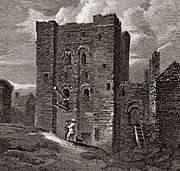Siege of Newcastle
Coordinates: 54°58′19″N 1°36′29″W / 54.972°N 1.608°W
| Siege of Newcastle | |||||||
|---|---|---|---|---|---|---|---|
| Part of the First English Civil War | |||||||
 Newcastle Castle | |||||||
| |||||||
| Belligerents | |||||||
|
|
| ||||||
| Commanders and leaders | |||||||
|
Earl of Leven Lt. Gen. Earl of Callander | Governor Sir John Marlay | ||||||
| Strength | |||||||
| Six regiments | |||||||
The Siege of Newcastle occurred in 1644, during the English Civil War. A Covenanter army from Scotland under the command of Lord General Alexander Leslie, 1st Earl of Leven crossed into England in January 1644. As he moved his army south he left six regiments under the direction of Lieutenant General James Livingstone, 1st Earl of Callander, to lay siege to the city of Newcastle-on-Tyne from 3 February (when the town was formally asked to surrender) until 19 October the same year when the Covenanters took the city by storm.[1][2][3] There had been an earlier occupation during the Civil War when the General Leslie had occupied the city following the Battle of Newburn in 1640.[4] The city was not continually invested in this time. In a complicated situation, as the Earl of Callander diverted his troops to take surrounding towns like Newburn, as the main Covenanter army pressed south. In the meantime, the royalist governor having reinforced his position then committed forces south also where the main Covenanter-Parliamentarian allied armies clashed with the Royalists at the Battle of Marston Moor.[5]
It was the defeat of the Royalist field army at Marston Moor on 2 July that decided the fate of Newcastle and all the other Royalist strongholds in the North East of England, because without the means of relief from an army in the field the capitulation of all such strongholds was only a matter of time.[2][3][6]
From 15 August 1644 Newcastle and Tynemouth were again the main target for Callander, now joined by the main Covenanters under Leven. Bombardment and mines were necessary to breach the walls. The western half fell on 19 October 1644. Those remaining loyal to the Royalist cause retreated into the Castle Keep. Finding the situation hopeless surrender was negotiated with General Leslie by the Royalist Governor, Sir John Marlay on 21 October 1644. The terms of surrender were generous: the promise of mercy for the garrison was fulfilled, although some of the Royalist leaders, including Marlay himself, suffered imprisonment or banishment.[7][8]
The Covenanters were delighted at the result, more so it is thought than the English Parliament. Tynemouth had fallen on 27 October 1644 and the Scots were now able to control the Tyneside coal trade for a second time which they did until they were persuaded to leave on 30 January 1647 with the demise of the Solemn League and Covenant.[5]
Notes
- ↑ Steve Murdoch and Alexia Grosjean, Alexander Leslie and the Scottish Generals of the Thirty Years' War, 1618-1648 (London, 2014), pp.134-137
- 1 2 Lindsay.
- 1 2 Plant 2006.
- ↑ Murdoch and Grosjean (2014), pp.134-136
- 1 2 Fraser & Emsley 1973, p. 37.
- ↑ Plant 2008.
- ↑ Murdoch and Grosjean (2014), pp.136-137
- ↑ Fraser & Emslay 1973, p. 37.
References
- Fraser, C M; Emsley, K (1973). Tyneside. Newton Abbot: David & Charles. pp. 35–38.
- Lindsay, Euan. "The Siege of Newcastle 1644". Scotwars. Archived from the original on 12 November 2011. Retrieved December 2011. Check date values in:
|accessdate=(help) - Plant, David (29 June 2006). "1644: Civil War in the North". British Civil Wars and Commonwealth website.
- Plant, David (27 June 2008). "The York March and Marston Moor,". British Civil Wars and Commonwealth website.
External links
- Grennan, Simon; Sperandio, Christopher (2011). Siege and Storm. Kartoon Kings. — comic book about the siege.
- "The Wear derby: Two tribes part 1". Retrieved December 2011. Check date values in:
|accessdate=(help) - "Newcastle, siege and civil war 1644". Retrieved December 2013. Check date values in:
|accessdate=(help) — Website. - "Siege and Storm". Retrieved December 2013. Check date values in:
|accessdate=(help) — the last few days of the Siege of Newcastle. A presentation prepared by Arpeggio Films for Tyne & Wear Archives & Museums. With an "interactive teaser". . The full film can be retrieved "here". .